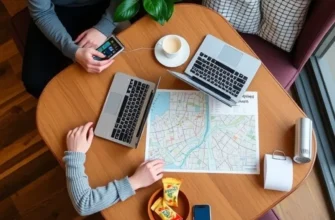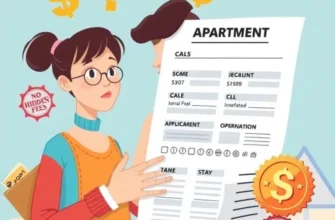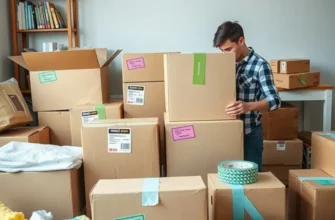Planning to move abroad? Whether you’re a recent grad taking your first big leap, a couple seeking adventure, or a family ready for a fresh start, relocating can be both exciting and, let’s admit, a bit overwhelming. It’s not just about packing your bags and waving goodbye; there’s a lot to consider when finding a home across the border! From paperwork you didn’t know existed to packing essentials (hello, duct tape!); this engaging checklist will guide you through the essential steps for a smooth move. Don’t worry, we’ll keep things light-hearted but packed with practical advice to help ensure your transition is as seamless as possible. Let’s dive into what you need to do to make sure your move is just another fun chapter in your life story!
Getting Prepared: The First Steps
Relocating abroad can be an exhilarating adventure, but without the right preparations, it can quickly turn into a logistic nightmare. Here are the essential steps you should take before making that leap.
First, dive into paperwork. Depending on your destination, you will need to handle visa applications, work permits, and other necessary documentation. Research the specific requirements and timelines, as these can vary significantly between countries. Ensure your passport is up to date, with at least six months’ validity. Image how something as simple as a passport expiration could derail your plans!
Secondly, tackle the financial aspects. Start by drafting a realistic budget that factors in moving expenses, initial accommodations, and daily living costs. Exchange rates can fluctuate, affecting the cost of living abroad. Consider setting up a local bank account in your new destination, which might provide better access to your funds.
Part of budgeting is planning for unexpected expenses, such as the cost of shipping or breakage during transit. Not all items you own will be worth transporting. Evaluate whether certain appliances or furniture should be purchased new after you move. For more insight on managing finances during a lease, explore financial tips for renters.
Researching your new home thoroughly is vital. Look beyond tourist guides and explore forums, local news sites, and social media groups to get a feel for the location. What are the local laws like? Knowing these can prevent you from falling into cultural faux pas or legal troubles. For instance, jaywalking is illegal in some cities and could lead to steep fines.
Understanding neighborhoods is another key factor. Neighborhood selection can significantly affect your living experience. It’s easy to fall for areas popular with tourists but these might not be ideal for long-term living. Consider factors such as commute times, local amenities, and safety metrics.
Getting a sense of city quirks can also help. Some places shut down early, whereas others come alive at night. Learn about public transportation—are there regular strikes or delays? Familiarity with these idiosyncrasies lets you plan more effectively.
Before signing any rental agreement, evaluate its terms closely. A year-long lease may initially seem perfect until you realize the neighborhood empties during summer breaks or holidays. Speak with current residents whenever possible or reach out to online communities to gather unbiased opinions.
Finalizing the prep work involves dealing with your current living situation. This might mean giving notice, selling items, or arranging storage. Make sure to note deadlines for utility terminations and address changes.
While this preparation may seem tedious, it sets you up for a smoother transition. It’s the foundation that supports your future overseas chapter, opening the door for discovery and growth without unnecessary hurdles.
Packing Like a Pro: Tips and Tricks

Ah, packing—the ultimate test of your organization skills and emotional resilience. This chapter delves into the art of packing wisely and efficiently, ensuring you avoid the classic pitfall of arriving at your new home with items you really didn’t need. Let’s make sure your favorite summer shirt isn’t buried under three layers of out-of-season clothes.
Categorize and Prioritize
Start by categorizing all your belongings into groups like clothing, kitchen supplies, and personal items. Break down each major category further, separating what you use weekly from those twice-a-year bits and bobs. Prioritizing helps streamline decision-making on what to pack first—those rarely used items can be packed in advance, while essentials remain accessible until the last minute.
Packing clothes can be particularly challenging. Consider the climate and cultural norms of your destination to eliminate unnecessary items. If you’re relocating to a tropical location, perhaps leave those winter boots in storage or sell them. Roll your clothes rather than folding them to save space and reduce wrinkles. Use vacuum-sealed bags for bulky items like jackets.
Efficient Box Labelling
Label your boxes on all sides with a simple and effective system. Include a quick descriptor like “kitchen – pots” or “bathroom – towels” on each side. Color coding these labels can further assist quick identification when unpacking in your new home. This approach ensures you can locate that elusive coffee mug after a long moving day.
Add a ‘priority’ sticker or marker to boxes containing essential items. This means essentials like toiletries, a first-aid kit, and a few sets of clothes won’t accidentally end up at the bottom of a pile. Before packing anything permanent, remember to set aside a personal survival bag containing must-have items for the first few days:
- Toiletries
- A change of clothes
- Important documents
- Chargers and adaptors
- Snacks
- Medications
Overlooked Must-Haves
While packing, it’s easy to overlook small yet crucial items. Bring a small toolkit equipped with screwdrivers, duct tape, and scissors. Such tools can be lifesavers when assembling furniture or fixing small issues upon arrival. Additionally, pack an extra set of keys separately from the main bunch to avoid a key-related mishap.
Also, consider adaptable items. A compact drying line or adhesive hooks can add immediate storage solutions in your new rental, breathing verses of calm into organizational chaos. Explore more renter-safe storage hacks to keep everything handy.
Remember, the goal is to make your new place feel like home as quickly as possible. Avoid stress by packing strategically, keeping priorities clear, and remembering that adaptability is your best friend in this new adventure. With some planning, you may even enjoy the process of discovering your clothes neatly rolled and buzzingly familiar as you settle into your new abode.
Final words
Moving abroad is a big step, full of excitement and challenges. By following this comprehensive checklist, you’ll sidestep unnecessary stress and embark on your new adventure with confidence. Remember that it’s perfectly normal to feel a mix of emotions, but every step you take is one step closer to settling into your new home and life. So grab your to-do list, a cup of coffee (or tea), and dive into this exciting chapter with gusto!









